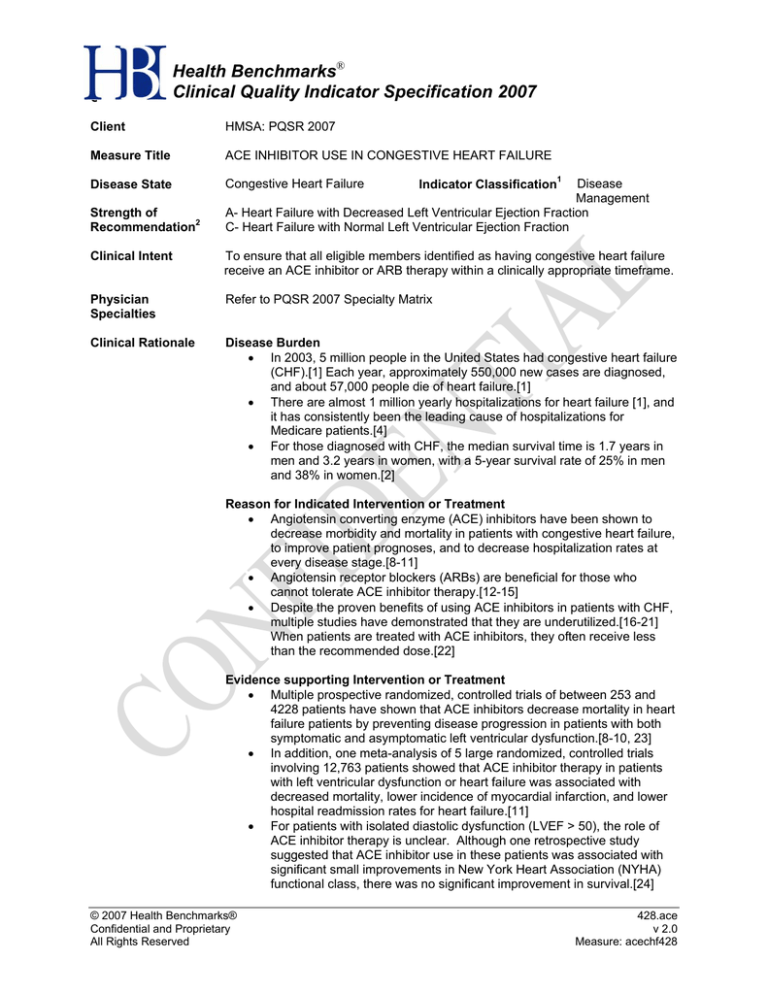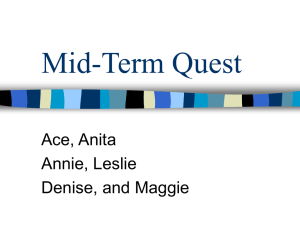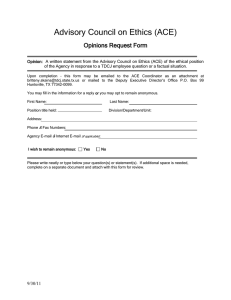
€
Health Benchmarks®
Clinical Quality Indicator Specification 2007
Client
HMSA: PQSR 2007
Measure Title
ACE INHIBITOR USE IN CONGESTIVE HEART FAILURE
Disease State
Congestive Heart Failure
Strength of
Recommendation2
Indicator Classification1
Disease
Management
A- Heart Failure with Decreased Left Ventricular Ejection Fraction
C- Heart Failure with Normal Left Ventricular Ejection Fraction
Clinical Intent
To ensure that all eligible members identified as having congestive heart failure
receive an ACE inhibitor or ARB therapy within a clinically appropriate timeframe.
Physician
Specialties
Refer to PQSR 2007 Specialty Matrix
Clinical Rationale
Disease Burden
• In 2003, 5 million people in the United States had congestive heart failure
(CHF).[1] Each year, approximately 550,000 new cases are diagnosed,
and about 57,000 people die of heart failure.[1]
• There are almost 1 million yearly hospitalizations for heart failure [1], and
it has consistently been the leading cause of hospitalizations for
Medicare patients.[4]
• For those diagnosed with CHF, the median survival time is 1.7 years in
men and 3.2 years in women, with a 5-year survival rate of 25% in men
and 38% in women.[2]
Reason for Indicated Intervention or Treatment
• Angiotensin converting enzyme (ACE) inhibitors have been shown to
decrease morbidity and mortality in patients with congestive heart failure,
to improve patient prognoses, and to decrease hospitalization rates at
every disease stage.[8-11]
• Angiotensin receptor blockers (ARBs) are beneficial for those who
cannot tolerate ACE inhibitor therapy.[12-15]
• Despite the proven benefits of using ACE inhibitors in patients with CHF,
multiple studies have demonstrated that they are underutilized.[16-21]
When patients are treated with ACE inhibitors, they often receive less
than the recommended dose.[22]
Evidence supporting Intervention or Treatment
• Multiple prospective randomized, controlled trials of between 253 and
4228 patients have shown that ACE inhibitors decrease mortality in heart
failure patients by preventing disease progression in patients with both
symptomatic and asymptomatic left ventricular dysfunction.[8-10, 23]
• In addition, one meta-analysis of 5 large randomized, controlled trials
involving 12,763 patients showed that ACE inhibitor therapy in patients
with left ventricular dysfunction or heart failure was associated with
decreased mortality, lower incidence of myocardial infarction, and lower
hospital readmission rates for heart failure.[11]
• For patients with isolated diastolic dysfunction (LVEF > 50), the role of
ACE inhibitor therapy is unclear. Although one retrospective study
suggested that ACE inhibitor use in these patients was associated with
significant small improvements in New York Heart Association (NYHA)
functional class, there was no significant improvement in survival.[24]
© 2007 Health Benchmarks®
Confidential and Proprietary
All Rights Reserved
428.ace
v 2.0
Measure: acechf428
•
•
•
With regard to angiotensin receptor blockers (ARBs), one meta-analysis
of 17 randomized, controlled trials involving 12,469 patients showed that
ARBs were not superior to ACE inhibitors in decreasing mortality or
hospitalizations, and do not decrease mortality rates in patients with
heart failure. However, ARB use was associated with significant
symptomatic improvement.[12]
Other randomized, controlled trials comparing ACE inhibitors and ARBs
in patients with heart failure show that ARBs are as effective, or possibly
slightly less effective than ACE inhibitors in terms of mortality and
progression of disease.[13, 14]
The CHARM trial, a randomized, controlled trial which studied 2028
patients with heart failure who could not tolerate ACE inhibitor therapy,
demonstrated that ARBs reduce cardiovascular mortality and
hospitalizations for heart failure.[15]
Clinical Recommendations
• The American College of Cardiology / American Heart Association
(ACC/AHA), in collaboration with the American College of Chest
Physicians and the International Society for Heart and Lung,
recommends the following in their 2005 guideline update (which was
endorsed by the Heart Rhythm Society) [25].
• Unless contraindicated, patients with both symptomatic and
asymptomatic left ventricular systolic dysfunction should be placed
on ACE inhibitors (Class I recommendation).
• Patients with symptomatic left ventricular dysfunction who cannot
tolerate an ACE inhibitor due to cough or angioedema should be
prescribed an angiotensin receptor blocker (Class I
recommendation).
• For patients with diastolic dysfunction, the ACC/AHA gives the use of
ACE inhibitors and angiotensin receptor blockers a Class IIb
recommendation.[26]
Source
Health Benchmarks, Inc. adapted from ACC/AMA/NQF Guidelines in the
following manner:
• Given that outcome data (EF<40%) is not available, HBI defines LVSD
as a test for LVSD followed by a diagnosis.
• HBI also requires each face to face outpatient visit to be accompanied by
a diagnosis of heart failure.
• HBI modified the identification period for the denominator to more
accurately capture events in question.
Denominator
Continuously enrolled members ages 20 years and older by the end of the
measurement year, who were identified as having congestive heart failure in the
year prior to the measurement year.
Relevant Billing Codes:
ICD-9 diagnosis code(s): 402.01, 402.11, 402.91, 404.01, 404.03,
404.11, 404.13, 404.91, 404.93, 428.0, 428.1, 428.20-428.23,
428.40-428.43
CPT-4 code(s): 99221-99223, 99231-99233, 99238-99239, 9925199255, 99261-99263, 99291-99300, 99356-99357, 99431-99440
© 2007 Health Benchmarks®
Confidential and Proprietary
All Rights Reserved
428.ace
v 2.0
Measure: acechf428
UB-92 revenue code(s): 0100-0114, 0117-0124, 0127-0134, 0137-0144,
0147-0154, 0157, 0190-0219, 0720-0729, 0800-0809, 0987, 100-114,
117-124, 127-134, 137-144, 147-154, 157, 190-219, 720-729, 800-809,
987
Denominator
Exclusion
Members with a diagnosis of angiodema, anuric renal failure, moderate to severe
aortic stenosis, or contraindications to ARB therapy and ACE inhibitors at
anytime prior to the end of the measurement year, or members who were
pregnant during the year after the index date. Contraindications to ARB and ACE
inhibitor therapy include hypokalemia, hypomagnesaemia, gout, systemic lupus
erythematosus, and chronic liver disease.
Relevant Billing Codes:
ICD-9 diagnosis code(s): 571.xx-573.9x, 630.xx-677.xx, 710.0x, 274.xx,
275.2x, 276.8x, 277.6x, 395.0x, 395.2x, 396.0x, 396.2x, 396.8x, 403.01,
403.11, 403.91, 404.02, 404.03, 404.12, 404.13, 404.92, 404.93, 425.1x,
440.1x, 584.xx-586.xx, 747.22, 788.5x
ICD-9 status “V” code(s): V22.xx, V23.xx, V24.xx, V27.xx, V28.xx,
V56.0x, V56.8x
ICD-9 surgical procedure code(s): 39.95, 54.98, 66.62, 69.0x, 72.xx75.xx
CPT-4 code(s): 59000, 59001, 59012, 59015, 59020, 59025, 59030,
59050, 59051, 59070, 59072, 59074, 59076, 59100, 59120, 59121,
59130, 59135, 59136, 59140, 59150, 59151, 59160, 59200, 59300,
59320, 59325, 59350, 59400, 59409, 59410, 59412, 59414, 59425,
59426, 59430, 59510, 59514, 59515, 59525, 59610, 59612, 59614,
59618, 59620, 59622, 59812, 59820, 59821, 59830, 59840, 59841,
59850, 59851, 59852, 59855, 59856, 59857, 59866, 59870, 59871,
59897, 59898, 59899, 76801, 76802, 76805, 76810, 76811, 76812,
76815, 76816, 76817, 76818, 76819, 76825, 76826, 76827, 76828,
76941, 76945, 76946, 80055, 82143, 82105, 82106, 82731, 88235,
88267, 88269
Numerator
Members who filled at least one prescription for an ACE inhibitor, or ARB therapy
during the year after the index date.
Interpretation of
Score
High score implies better performance
Physician
Attribution
Score all physicians (in the selected specialties) who saw the member during the
year after the index date.
References
1.
2.
3.
4.
© 2007 Health Benchmarks®
Confidential and Proprietary
All Rights Reserved
Heart Disease and Stroke Statistics - 2006 Update. 2004, American
Heart Association, American Stroke Association. p. 21.
Ho, K.K., et al., The epidemiology of heart failure: the Framingham
Study. J Am Coll Cardiol, 1993. 22(4 Suppl A): p. 6A-13A.
Hurst, W., The Heart, Arteries and Veins. 10th ed. 2002, New York, NY:
McGraw-Hill.
Massie, B.M. and N.B. Shah, The heart failure epidemic: magnitude of
the problem and potential mitigating approaches. Curr Opin Cardiol,
1996. 11(3): p. 221-6.
428.ace
v 2.0
Measure: acechf428
5.
6.
7.
8.
9.
10.
11.
12.
13.
14.
15.
16.
17.
18.
19.
20.
21.
© 2007 Health Benchmarks®
Confidential and Proprietary
All Rights Reserved
Davie, A.P., et al., The prevalence of left ventricular diastolic filling
abnormalities in patients with suspected heart failure. Eur Heart J, 1997.
18(6): p. 981-4.
Litwin, S.E. and W. Grossman, Diastolic dysfunction as a cause of heart
failure. J Am Coll Cardiol, 1993. 22(4 Suppl A): p. 49A-55A.
Dougherty, A.H., et al., Congestive heart failure with normal systolic
function. Am J Cardiol, 1984. 54(7): p. 778-82.
Effects of enalapril on mortality in severe congestive heart failure.
Results of the Cooperative North Scandinavian Enalapril Survival Study
(CONSENSUS). The CONSENSUS Trial Study Group. N Engl J Med,
1987. 316(23): p. 1429-35.
Effect of enalapril on mortality and the development of heart failure in
asymptomatic patients with reduced left ventricular ejection fractions.
The SOLVD Investigattors. N Engl J Med, 1992. 327(10): p. 685-91.
Effect of enalapril on survival in patients with reduced left ventricular
ejection fractions and congestive heart failure. The SOLVD Investigators.
N Engl J Med, 1991. 325(5): p. 293-302.
Flather, M.D., et al., Long-term ACE-inhibitor therapy in patients with
heart failure or left-ventricular dysfunction: a systematic overview of data
from individual patients. ACE-Inhibitor Myocardial Infarction Collaborative
Group. Lancet, 2000. 355(9215): p. 1575-81.
Jong, P., et al., Angiotensin receptor blockers in heart failure: metaanalysis of randomized controlled trials. J Am Coll Cardiol, 2002. 39(3):
p. 463-70.
Pitt, B., et al., Effect of losartan compared with captopril on mortality in
patients with symptomatic heart failure: randomized trial--the Losartan
Heart Failure Survival Study ELITE II. Lancet, 2000. 355(9215): p. 15827.
Pfeffer, M.A., et al., Valsartan, captopril, or both in myocardial infarction
complicated by heart failure, left ventricular dysfunction, or both. N Engl J
Med, 2003. 349(20): p. 1893-906.
Granger, C.B., et al., Effects of candesartan in patients with chronic heart
failure and reduced left-ventricular systolic function intolerant to
angiotensin-converting-enzyme inhibitors: the CHARM-Alternative trial.
Lancet, 2003. 362(9386): p. 772-6.
Edep, M.E., et al., Differences between primary care physicians and
cardiologists in management of congestive heart failure: relation to
practice guidelines. J Am Coll Cardiol, 1997. 30(2): p. 518-26.
McDermott, M.M., et al., Heart failure between 1986 and 1994: temporal
trends in drug-prescribing practices, hospital readmissions, and survival
at an academic medical center. Am Heart J, 1997. 134(5 Pt 1): p. 901-9.
Smith, N.L., et al., Temporal patterns in the medical treatment of
congestive heart failure with angiotensin-converting enzyme inhibitors in
older adults, 1989 through 1995. Arch Intern Med, 1998. 158(10): p.
1074-80.
Bart, B.A., et al., Contemporary management of patients with left
ventricular systolic dysfunction. Results from the Study of Patients
Intolerant of Converting Enzyme Inhibitors (SPICE) Registry. Eur Heart J,
1999. 20(16): p. 1182-90.
Kermani, M., A. Dua, and A.H. Gradman, Underutilization and clinical
benefits of angiotensin-converting enzyme inhibitors in patients with
asymptomatic left ventricular dysfunction. Am J Cardiol, 2000. 86(6): p.
644-8.
Echemann, M., et al., Determinants of angiotensin-converting enzyme
inhibitor prescription in severe heart failure with left ventricular systolic
dysfunction: the EPICAL study. Am Heart J, 2000. 139(4): p. 624-31.
428.ace
v 2.0
Measure: acechf428
22.
23.
24.
25.
26.
27.
© 2007 Health Benchmarks®
Confidential and Proprietary
All Rights Reserved
Luzier, A.B., et al., Impact of angiotensin-converting enzyme inhibitor
underdosing on rehospitalization rates in congestive heart failure. Am J
Cardiol, 1998. 82(4): p. 465-9.
Pfeffer, M.A., et al., Effect of captopril on mortality and morbidity in
patients with left ventricular dysfunction after myocardial infarction.
Results of the survival and ventricular enlargement trial. The SAVE
Investigators. N Engl J Med, 1992. 327(10): p. 669-77.
Philbin, E.F., et al., Systolic versus diastolic heart failure in community
practice: clinical features, outcomes, and the use of angiotensinconverting enzyme inhibitors. Am J Med, 2000. 109(8): p. 605-13.
Hunt, S.A., ACC/AHA 2005 guideline update for the diagnosis and
management of chronic heart failure in the adult: a report of the
American College of Cardiology/American Heart Association Task Force
on Practice Guidelines (Writing Committee to Update the 2001
Guidelines for the Evaluation and Management of Heart Failure). J Am
Coll Cardiol, 2005. 46(6): p. e1-82.
Hunt, S.A., et al., ACC/AHA guidelines for the evaluation and
management of chronic heart failure in the adult: Executive summary - A
report of the American College of Cardiology/American Heart Association
Task Force on Practice Guidelines (Committee to revise the 1995
Guidelines for the Evaluation and Management of Heart Failure). Journal
Of The American College Of Cardiology, 2001. 38(7): p. 2101-2113.
Heart Failure Measurement Set. 2005 [cited 2005 January 26]; Available
from: http://www.ama-assn.org/ama/pub/category/15777.html.
428.ace
v 2.0
Measure: acechf428
1
Indicator Classification (Adapted from Health Plan Employer Data Information Set (HEDIS®) technical
specifications)
Diagnosis
Measures applicable to patients receiving diagnostic workups for a symptom or
condition that delineate appropriate laboratory or radiological testing to be
performed (e.g. evaluation of thyroid nodule; pregnancy test in patients with
vaginal bleeding or abdominal pain)
Effectiveness of Care
Prevention
Screening
Measures applicable to asymptomatic individuals that are designed to prevent
the onset of the targeted condition (e.g. immunizations).
Measures applicable to asymptomatic patients who have risk factors or preclinical disease, but in whom the condition has not become clinically apparent
(e.g. pap smears; screening for elevated blood pressure).
Disease
Management
Measures applicable to individuals diagnosed with a condition that are part of the
treatment or management of the condition (e.g. cholesterol reduction in patients
with diabetes; radiation therapy following breast conserving surgery; appropriate
follow-up after acute event).
Medication
Monitoring
Measures applicable to patients taking medications with narrow therapeutic
windows and / or potential preventable significant side effects or adverse
reactions (e.g. thyroid stimulating hormone (TSH) testing after levothyroxine dose
change; hepatic enzyme monitoring for patients using antimycotic
pharmacotherapy)
Medication
Adherence
Measures applicable to patients taking medications for chronic conditions that
are designed to assess patient adherence to medication (e.g. adherence to lipid
lowering medication).
Utilization
Measures applicable to patients receiving treatment for a symptom or condition
that advocate appropriate utilization of laboratory and pharmaceutical resources
(e.g. conservative use of imaging for low back pain; inappropriate use of
antibiotics for viral upper respiratory infection).
© 2007 Health Benchmarks®
Confidential and Proprietary
All Rights Reserved
428.ace
v 2.0
Measure: acechf428
2
Strength of Recommendation
Strength of Recommendation Based on a Body of Evidence
FIGURE 2. Algorithm for determining the strength of a recommendation based on a body of evidence
(applies to clinical recommendations regarding diagnosis, treatment, prevention, or screening). While this
algorithm provides a general guideline, authors and editors may adjust the strength of recommendation
based on the benefits, harms, and costs of the intervention being recommended. (USPSTF = U.S.
Preventive Services Task Force)
© 2007 Health Benchmarks®
Confidential and Proprietary
All Rights Reserved
428.ace
v 2.0
Measure: acechf428






